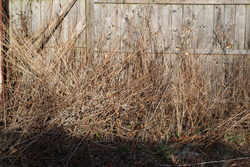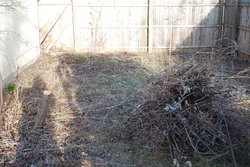Spring cleaning for my native plants

The "Back 40" of my little backyard prairie after a long, snowy winter
Rick Meader|Contributor
My little prairie measures about one-one-thousandth of an acre, but it’s mine, and I nurse it to life every spring with my choppers. Burning is the preferred method for maintaining a prairie, but my wood garage and wood fences, neighbors within 60 feet, a denial from our fire marshal to burn my yard and a fire station a half-block away (easy smoke-sniffing distance) all keep me on the honest side of the no burning laws of the township. Still, I have this tangle of last year’s growth that needs to be removed to warm up the earth to favor the warm weather species of a prairie. So, bring out the choppers!
In case you haven’t been exposed to the glory of a prairie fire, try to sometime. They’re amazing, and inspiring…and fun! They also are an extremely efficient way of removing the thatch from last year’s growth, and help to return the nutrients from that growth back the soil. And, the scorched earth’s blackness warms up the soil for the deep-rooted prairie plants to start their new growth. Good reasons like that are all a pyromaniac (a law-abiding pyromaniac) like me needs to want to burn my yard, but the desire to keep myself fine-free and out of jail lead me to the next best option - chopping. If you can remove the thatch to a pretty low level (like less than 6 inches) so the sun can get to the ground, that will provide at least some of the benefits of the fire and provide more exercise as well.
Another benefit to cutting is giving another chance for insects that hide inside plant stems for the winter to escape and live a good bug’s life. According to Douglas Tallamy in "Bringing Nature Home," plant bugs (family Miridae - don’t worry, I’m learning too) are one family of bugs that insert their eggs into plant stems for their protected development. After I hack the thatch down, I form a loose pile of the thatch which I leave for a few weeks. I figure if they don’t take advantage of this opportunity to escape into my yard, they can escape at the composting facility where I send the pile.
One final benefit is that the seeds remaining on the plant aren’t burned up in the fire and may have a chance to disperse and sow themselves, although Greg Vaclavek of Native Plant Nursery told me he has found that seeds remaining on the plant over a winter often aren’t all that fertile.

My prairie, chopped down and ready to grow!
Along that line, I wanted to propose something to you who read this blog (thanks, by the way). As you see plants start to pop up, please write a comment at the end of my blog when and where you see them so others can enjoy them, even if it’s just vicariously. (AnnArbor.com is okay with this.) As I mentioned before, I’m a member of the Wild Ones native landscaping group, and it’s always an exciting time in the spring when people start reporting “sightings” on the Web e-mail list. Okay, it may not be exciting to everyone, but it is to me, so please share! In the meantime, enjoy nature everyone!
Rick is a local landscape architect with a special interest in all things natural, including native plants and the critters that eat them. You can contact him at yourland1824@gmail.com.


Comments
Rork Kuick
Tue, Mar 23, 2010 : 9:27 a.m.
I also wouldn't mind hearing and sharing stories about most-invasive ornamental plants, particularly in spring when folks might be tempted by them. I have experienced several that I wish I had never known. For example, even though I have never intentionally obtained asiatic dayflower (Commelina communis), somehow I caught it, and have been fighting it for about a decade. Several other easy-to-grow plants can become your worst nightmares, and your neighbors' nightmares as well. Beware.